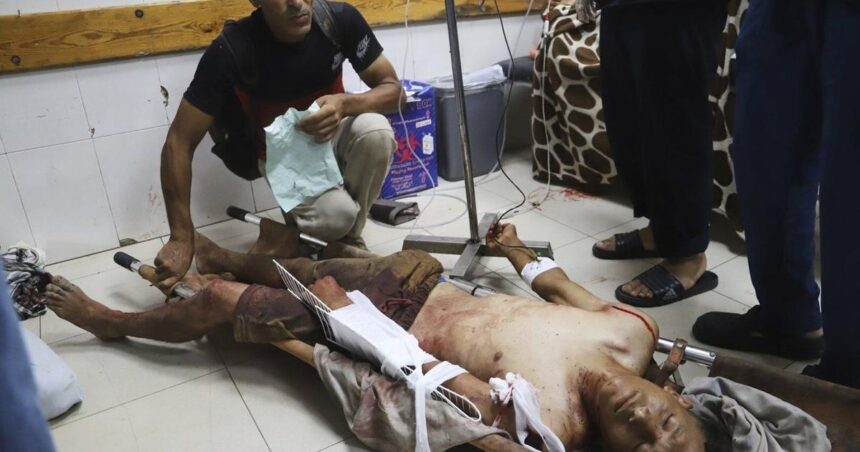I’ve spent three days on the outskirts of Gaza City, watching the desperate calculations people make when hunger becomes unbearable. Yesterday morning’s tragedy was predictable to anyone who’s witnessed the deterioration of humanitarian corridors here.
At least 30 Palestinians were killed and 150 wounded while attempting to reach food distribution points in northern Gaza, according to Gaza health officials. The deaths occurred near Kuwait Roundabout as thousands of desperate civilians converged on trucks carrying flour and canned goods.
“We hadn’t eaten in three days,” said Mahmoud al-Kahlout, 43, who spoke to me while being treated for a gunshot wound at Al-Ahli Hospital. “When we heard about the aid trucks, everyone ran. There was no organization, no protection. Then the shooting started.”
The Israeli military and Palestinian officials present contradicting accounts of what transpired. The IDF claims its forces fired warning shots when crowds “approached in a manner that endangered” soldiers, while Gaza authorities characterize the incident as a “massacre of starving people.”
What’s undeniable is the humanitarian catastrophe unfolding across Gaza. The UN’s World Food Programme has warned that 570,000 people in Gaza—roughly a quarter of the population—are experiencing “catastrophic” hunger. Aid distribution has become increasingly chaotic as formal systems collapse under the weight of continued fighting.
I’ve covered food insecurity in Yemen, South Sudan, and eastern Ukraine, but the speed of Gaza’s descent into hunger is unprecedented in my reporting career. Just six months ago, this was a functioning society with food markets and regular commerce.
Dr. Adnan Bursh, emergency physician at Al-Shifa Hospital, described treating malnutrition cases that have become commonplace. “We’re seeing children with protein deficiencies we never encountered before the war,” he told me. “Their bodies are consuming themselves.”
The Kuwait Roundabout incident represents the deadliest single aid distribution event since the war began. Survivors describe a chaotic scene where multiple factors—overwhelming crowd pressure, military checkpoints, and general desperation—created perfect conditions for tragedy.
The UN Office for the Coordination of Humanitarian Affairs (OCHA) has documented at least 12 previous incidents where civilians were killed while seeking humanitarian assistance. These patterns suggest systematic problems in aid delivery that transcend any single incident.
US Secretary of State Antony Blinken called the deaths “tragic and unacceptable,” while reiterating American efforts to increase aid flow. However, his statements reflect the widening gap between diplomatic language and ground realities. Promises of aid corridors mean little when implementation remains broken.
The World Food Programme notes that northern Gaza faces particularly severe conditions. Areas like Jabalia and Beit Hanoun receive approximately 10% of required food aid, creating scenarios where civilians must risk their lives to reach distribution points.
Looking at broader patterns, yesterday’s deaths reflect the weaponization of hunger that becomes inevitable in prolonged urban conflicts. I’ve documented similar dynamics in Aleppo and Mariupol, where control of food becomes inseparable from military objectives.
“They know exactly where we are and when aid arrives,” said Fatima Zureiq, a mother of four who waited eight hours for flour last week. “The fighting never stops for food—we must stop for fighting.”
International humanitarian law is explicit about obligations to allow civilian access to essential supplies. The Geneva Conventions require warring parties to ensure humanitarian access and prohibit starvation as a method of warfare. Yet enforcement mechanisms have proven ineffective in Gaza’s complex political landscape.
The European Union’s humanitarian commissioner Janez Lenarčič called for an immediate investigation, stating that “protection of civilians seeking life-saving assistance is non-negotiable under international law.” However, investigations rarely translate to meaningful accountability during active conflicts.
For aid workers on the ground, the situation has become nearly impossible. Médecins Sans Frontières (MSF) reports that their teams must navigate constantly shifting security parameters that change without notice.
“We’re making life-and-death decisions about aid routes with fragmented information,” a senior MSF coordinator told me, speaking on condition of anonymity due to security concerns. “The coordination mechanisms have broken down entirely.”
Meanwhile, ordinary Gazans develop their own survival intelligence networks. Through WhatsApp groups and word of mouth, information about aid deliveries spreads rapidly, creating the massive convergences that make distribution points simultaneously vital lifelines and potential death traps.
What happens next will depend largely on whether yesterday’s deaths generate enough international pressure to force changes in aid delivery protocols. History suggests temporary improvements followed by regression to dangerous patterns.
For Gazans like Mahmoud al-Kahlout, still recovering from his wounds, the calculations remain grimly practical: “Next time there is food, I will still go. We will die from hunger otherwise. At least this way there is a chance.”






